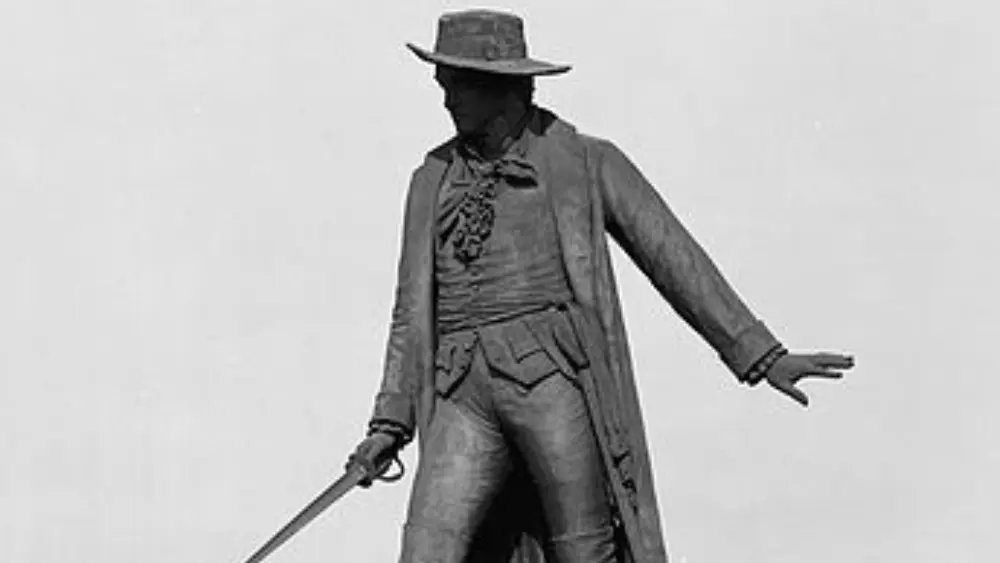William Prescott, born on February 20, 1726, in Groton, Massachusetts, is celebrated as a courageous military leader and hero of the American Revolutionary War, particularly for his actions during the Battle of Bunker Hill. His unwavering determination and leadership in the face of overwhelming odds made him an emblematic figure in the early days of the American Revolution.
Early Life and Military Background
A profound connection to a family steeped in military tradition marked William Prescott’s early life, setting him on a destined path for a life of service and leadership from birth. As a child, he heard inspiring stories, fostering patriotism and a strong commitment to protect his homeland. This upbringing laid the foundation for his remarkable military career, shaping him into a fearless and capable leader on the battlefield.
Prescott’s military journey commenced during the tumultuous era of the French and Indian War. It was on these battlefields that he honed his skills in combat and leadership, earning the respect of his comrades and superiors alike. His experiences in this conflict provided invaluable lessons in tactics, strategy, and the unyielding spirit required in times of war. These early years in the military would prove crucial, as they equipped Prescott with the expertise and confidence that would serve him well in the future, particularly during the American Revolutionary War, when his leadership would be instrumental in some of the most pivotal moments in American history.
William Prescott: The Battle of Bunker Hill
One of William Prescott’s most notable contributions to American history occurred during the Siege of Boston in 1775. On June 17, 1775, during the Battle of Bunker Hill, Prescott was tasked with defending Breed’s Hill, a strategic position overlooking Boston. This battle marked a pivotal moment in the early stages of the American Revolutionary War. Prescott and his men faced off against British forces led by General Thomas Gage, who was determined to break the siege and regain control of the city.
Under Prescott’s leadership, American militia volunteers displayed exceptional bravery and determination, despite being outnumbered and lacking proper training and supplies. The famous order attributed to Prescott, “Don’t fire until you see the whites of their eyes,” reflected the dire need to conserve ammunition. Though the British ultimately captured the hill after several assaults, they suffered significant casualties, while the American forces demonstrated their resolve and ability to stand their ground. The Battle of Bunker Hill showcased the colonists’ determination and willingness to fight for their independence, setting the stage for a long and arduous struggle for liberty against British colonial rule and ultimately leading to the birth of the United States of America.
Leadership and Fortifications
Prescott’s leadership was instrumental in fortifying Breed’s Hill during the Battle of Bunker Hill. Despite facing outnumbered odds and lacking proper fortification tools, he demonstrated remarkable strategic acumen. Prescott’s ability to inspire and direct his men in constructing a substantial defensive earthwork played a crucial role in the battle’s outcome. His famous order, “Don’t fire until you see the whites of their eyes,” demonstrated his understanding of the limited resources and ammunition available to the American forces and the need to make every shot count.
Under Prescott’s guidance, the American militia volunteers worked tirelessly to create a formidable defensive position, which proved to be a formidable obstacle for the British forces. This earthwork not only showcased the resilience of the American patriots but also served as a symbol of their commitment to defending their cause. Prescott’s leadership during the fortification process and throughout the battle exemplified the determination and resourcefulness of the American colonists as they faced overwhelming odds in their struggle for independence. His actions on that fateful day left an indelible mark on the early stages of the American Revolutionary War and continue to be celebrated as a testament to leadership under adversity.
William Prescott: Heroic Stand
William Prescott’s heroic stand during the battle exemplified unwavering resolve and exceptional military prowess. Positioned atop Bunker Hill, he and his determined men staunchly guarded their post against the relentless British forces, expertly commanded by General William Howe. Prescott’s leadership and the remarkable discipline of his soldiers came to the forefront as they engaged in fierce combat. Their marksmanship was nothing short of remarkable, as they relentlessly picked off British soldiers with deadly accuracy.
In the face of relentless British assaults, Prescott’s men’s unyielding determination and precision shooting inflicted heavy casualties upon the enemy. Their resistance was a testament to the strength of their conviction and their commitment to the cause of American independence. As the battle raged on, the British were forced to launch multiple costly frontal assaults, paying a steep price for every inch of ground they sought to conquer. Prescott’s leadership and the valor of his men in the heat of battle became a symbol of American resilience and fortitude in the struggle for freedom, inspiring countless others to stand their ground and fight for the birth of a new nation. William Prescott’s heroic stand on that fateful day etched his name into the annals of American history as a true patriot and an unwavering defender of liberty.
Evacuation and Legacy
As the Battle of Bunker Hill raged on, William Prescott’s position atop the hill became increasingly untenable in the face of the relentless British assaults. Recognizing the need to preserve his remaining troops, Prescott made the difficult decision to order a strategic withdrawal. While this retreat marked the end of the battle, it did not signify defeat in the broader sense. Prescott’s tactical decision to withdraw prevented the complete capture of his forces and allowed his men to live to fight another day. This choice demonstrated not only his military acumen but also his commitment to the larger cause of American independence.
The Battle of Bunker Hill, although technically won by the British, was a Pyrrhic victory. The cost of victory was staggering, as they suffered significant casualties in their relentless frontal assaults on Prescott’s fortified position. This battle became a pivotal moment in the American Revolution, serving as a stark reminder of the determination and resolve of the American forces. It bolstered their morale, galvanizing them for the challenges that lay ahead. The legacy of the Battle of Bunker Hill lived on as a symbol of the sacrifices made in the pursuit of freedom, laying the foundation for the birth of a new nation.

William Prescott: Legacy
William Prescott’s legacy in the annals of American history is indelible, for his leadership and valor at the Battle of Bunker Hill left an enduring mark on the American Revolution. His unwavering commitment to the cause of independence became emblematic of the American spirit, inspiring countless patriots to stand up against British oppression. Prescott’s most famous command, urging his men to withhold their fire until they could see “the whites of their eyes,” encapsulated the resourcefulness and determination of colonial forces. It demonstrated their ability to make the most of limited resources and to employ ingenious tactics in the face of formidable adversaries.
Prescott’s actions at Bunker Hill reverberated throughout the revolution, instilling a sense of pride and unity among the American troops. His legacy continued to inspire generations of Americans to come, reminding them of the sacrifices and determination of those who came before. William Prescott’s name stands as a testament to the enduring spirit of liberty and the profound impact that a single individual’s leadership and courage can have in shaping the course of history.
Post-War Life
Following his service in the Revolutionary War, William Prescott transitioned back into civilian life in his home state of Massachusetts. Although he had played a pivotal role in the war, Prescott’s commitment to the ideals of the American Revolution did not end with the conflict’s conclusion. He continued to be an engaged and influential member of his community, dedicating his talents and leadership to various roles.
Among his notable post-war accomplishments, William Prescott served as a judge, demonstrating his commitment to upholding the rule of law and contributing to the development of the young nation. Prescott’s post-war contributions underscored his enduring dedication to the principles of liberty and justice that had driven him to action during the Revolutionary era, leaving a lasting legacy that extended beyond the battlefield.




